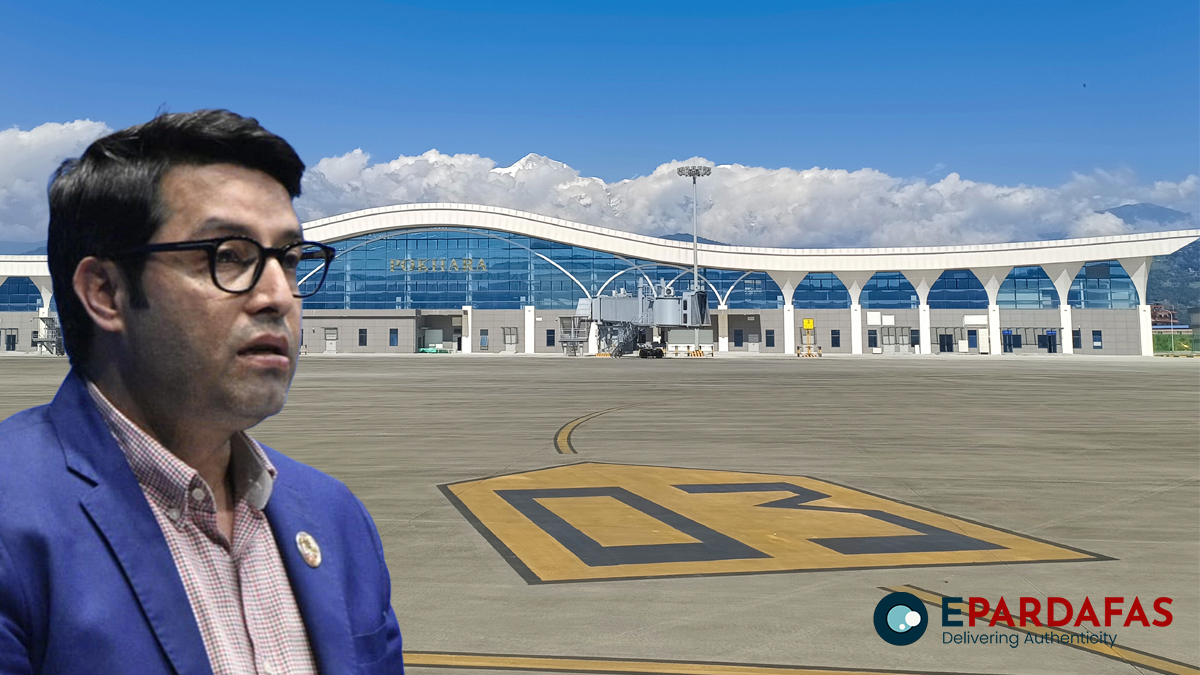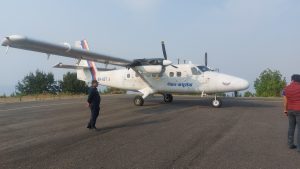
MP Bajgain Raises Alarm Over Pokhara Airport’s Economic Struggles

In a recent Twitter statement, Parliament Member Rajendra Bajgain raised alarming concerns about the economic burden posed by Nepal’s Pokhara International Airport. Despite initial hopes of alleviating traffic at Tribhuvan International Airport and boosting regional tourism, recent revelations shed light on the airport’s financial struggles since its inauguration.
The airport, which was handed over to the government following an agreement with China’s state-owned contractor CAMCE, has faced challenges in attracting international airlines. Currently, only a handful of domestic flights operate from the airport, with no significant interest from airlines to initiate international flights.
Bajgain voiced concerns about the financial implications of Nepal’s loan from China for the airport’s construction in a Twitter statement. With an outstanding debt of 22 billion Rupees, the airport faces challenges in attracting international airlines since its inauguration, raising doubts about its revenue-generating potential.
Bajgain highlights the first maturity deadline of the loan in 2022 and a subsequent one in October 2023, with a penalty and substantial annual interest rate compounding Nepal’s economic worries. The 5% annual interest rate alone accumulates to a significant Rs 110,299,200, adding to the financial strain.
तिर्ने कि छिर्ने?
पोखरा एअरपोर्टको ऋणमा हामी नेपाली!
झलनाथ जी की जय!पोखरा विमानस्थलको ऋण २२०५९८४०००० (1378740000 CHINESE CURRENCY) अर्थात् २२ अर्ब नेरू को पहिलो ब्याज चुक्ता गर्ने हद ईसं २०२२ र दोस्रो समयावधी २०२३ अक्टोबर गुज्रिसक्यो। यसको पेनाल्टी के हो थाह छैन तर ब्याजदर…
— Rajendra Bajgain (Raj) (@Rajgurkha) November 24, 2023
China is set to enhance its presence in Pokhara and surrounding areas by utilizing the Pokhara International Airport. On January 1, Prime Minister Pushpa Kamal Dahal ‘Prachanda’ inaugurated the regional international airport, which was constructed with assistance from China, in the popular tourist destination of Pokhara in western Nepal. Initially, the airport served only domestic flights but, six months later, on June 21, it welcomed its first international flight from Chengdu Airport in China, operated by Sichuan Airlines.
The construction of Pokhara International Airport was funded through a loan of Rs 22 billion from China’s Exim Bank. However, Nepal is facing challenges in repaying this debt, as the country must generate profits from operating the airport to cover the loan. China has further fueled controversy surrounding the project by stating that it falls under the Belt and Road Initiative (BRI).
Chinese Ambassador to Nepal, Chen Song, once again reiterated that Pokhara International Airport is a significant flagship project of China’s ambitious Belt and Road Initiative (BRI). His remarks were made during the first international commercial plane landing event at the airport on 21st June.
Ambassador Song also previously had emphasized the airport’s connection to the BRI during its inauguration. On December 31, the Chinese Embassy in Nepal proudly declared the Pokhara Regional International Airport (PRIA) as a prominent flagship project of the BRI. However, in reality, the concessional loan agreement between the Civil Aviation Authority of Nepal and China EXIM Bank had not mentioned the BRI. The work of Pokhara International Airport had already started even before the BRI scheme enters Nepal.
In 2012, an agreement was reached between Nepal and China to build the airport in Nepal. In May 2014, two years before the loan was agreed, China CAMC Engineering was given the construction contract, at a time when China’s BRI was in a nascent phase. Chinese President Xi first announced the idea of BRI in 2013 as ‘One Belt, One Road’.
After Nepal and China signed the framework agreement on BRI in 2017, Nepal had initially selected 35 projects to be undertaken under Chinese President Xi Jinping’s flagship connectivity project. Later, upon Beijing’s request, the total number of projects was whittled down to nine with Pokhara airport off the list.
The limited number of charter flights in Pokhara airport highlights the struggle to attract international airlines and fulfill the airport’s intended purpose.
With the loan’s grace period set at seven years and a repayment term of 20 years, Nepal faces a daunting financial challenge.
Bajgain’s concerns underscore the need for a comprehensive strategy to address the financial burden and ensure the economic sustainability of Pokhara International Airport.












Comments